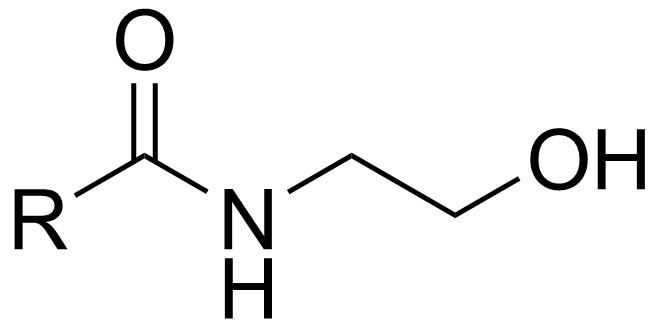An N-acylethanolamine (NAE) is a type of fatty acid amide formed when one of several types of acyl group is linked to the nitrogen atom of ethanolamine. These amides conceptually can be formed from a fatty acid and ethanolamine with the release of a molecule of water, but the known biological synthesis uses a specific phospholipase D to cleave the phospholipid unit from N-acylphosphatidylethanolamines. Another route relies on the transesterification of acyl groups from phosphatidylcholine by an N-acyltransferase (NAT) activity. The suffixes -amine and -amide in these names each refer to the single nitrogen atom of ethanolamine that links the compound together: it is termed "amine" in ethanolamine because it is considered as a free terminal nitrogen in that subunit, while it is termed "amide" when it is considered in association with the adjacent carbonyl group of the acyl subunit. Names for these compounds may be encountered with either "amide" or "amine" varying by author.
Examples of N-acylethanolamines include:
Anandamide (N-arachidonoylethanolamine; NAE 20:4) or arachidonlyethanolamine (AEA) is the amide of arachidonic acid (20:4 ω-6) and ethanolamine. It is the ligand of both cannabinoid receptors and vanilloid receptor that attenuates pain sensation.
N-Palmitoylethanolamine is the amide of palmitic acid (16:0) and ethanolamine. It has anti-inflammatory activity and also attenuates pain sensation. in mammals. NAE 16:0 has also been identified in plants including corn, and seeds of cotton, okra, tomato, castor bean, soya bean and peanuts, but its physiological functions remain unknown.
N-Oleoylethanolamine is the amide of oleic acid (18:1) and ethanolamine. It has anorexic effects and enables fat breakdown by stimulating PPAR-alpha. In plants NAE 18:1 is present abundantly in dry seeds and levels decline during seed imbibition, but its physiological functions are yet to be elucidated.
N-Stearoylethanolamine is the amide of stearic acid (18:0) and ethanolamine. It has pro-apoptotic activity. It operates independently of the known cannabinoid and vanilloid receptors targeted by anandamide.
N-Docosahexaenoylethanolamine is the amide of docosahexaenoic acid (22:6) and ethanolamine. It has anti-proliferative effects on prostate cancer cell lines and promotes synaptogenesis.
These bioactive lipid amides are generated by the membrane enzyme NAPE-PLD, and natural bile acids regulate this essential process.

